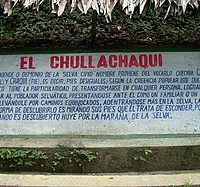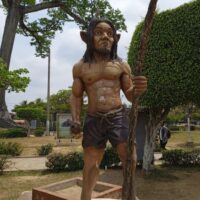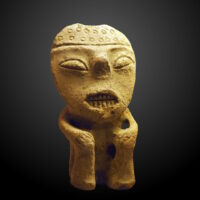Chullachaki : The One Footed Guardian
Listen
At a glance
| Description | |
|---|---|
| Origin | South American Mythology |
| Classification | Spirits |
| Family Members | N/A |
| Region | Peru, Brazil |
| Associated With | Child Abduction |
Chullachaki
Introduction
In the heart of the Peruvian and Brazilian Amazon, where the forest hums with unseen life and mystery, the legend of the Chullachaki remains one of the most enduring tales of indigenous folklore. His name comes from the Quechua words chulla (uneven) and chaki (foot), a clear reference to the deformity that betrays his disguise. Both feared and respected, the Chullachaki is described as a spirit who watches over the rainforest, punishes intruders, and lures the unwary into confusion. For local communities, he is not just a mythical trickster but a reminder of the sacred balance between people and the jungle. The myth continues to be retold as a way of explaining the dangers of straying too far from the community, while also highlighting the forest’s deep spiritual power.
Physical Traits
The Chullachaki’s most recognizable feature is his mismatched feet—one human and the other animal-like, sometimes resembling the hoof of a deer or goat, a turtle’s claw, or even turned backward. This deformity leaves deceptive footprints, making it nearly impossible to track him properly. He is usually described as a dwarf-like figure, short and disheveled, his body often hidden under ragged clothes. Some traditions add details like a wide-brimmed hat to conceal his wrinkled face, sharp nose, and glowing red eyes, while his pointed ears give him an elfin or demonic quality.
His unsettling appearance serves as a warning sign. Locals believe that if you suspect someone in the forest is not who they claim to be, you should check their feet—if one looks unnatural, it may be the Chullachaki in disguise.
Family
Unlike human beings, the Chullachaki is not usually imagined as part of a conventional family. Instead, he is seen as belonging to an ancient race of forest spirits that predate humanity. Legends say that he and his kin live deep in the jungle, cultivating hidden gardens and existing in parallel with human society. At times, he disrupts human families by stealing children or seducing adults, who are then said to transform into beings like him, permanently separated from their loved ones.
This act of taking children or imitating relatives reveals another side of his myth: the manipulation of family bonds. To lure a person into the wilderness, the Chullachaki often appears as a missing sibling, cousin, or childhood friend. Once trust is gained, he leads the victim further into the rainforest, where they may vanish forever.
Other names
The spirit is most widely known as Chullachaki, though variations like Chuyachaki and Chulyachaki are also common. In some regions, he is called Shapishico, a name that highlights his ability to shift shapes and deceive. Among Yaminawa speakers, he may be referred to as Xapixiko, while other Amazonian traditions equate him with similar forest spirits such as the Sacharuna, who likewise dwell in hidden corners of the jungle. These multiple names reflect the wide reach of his legend across Amazonian cultures, showing how the story has adapted to local languages and traditions while maintaining the same core identity of the uneven-footed trickster.
Powers and Abilities
The Chullachaki’s greatest strength lies in his shapeshifting ability. He can transform into any animal of the jungle—jaguars, monkeys, snakes—or even into a trusted human companion. Hunters often speak of being tricked by him appearing as a familiar animal, only to find themselves hopelessly lost after following the false trail. For families, he may appear as a loved one, convincing them to wander deeper into the forest where his true intentions are revealed.
Beyond mimicry, the Chullachaki is also considered a guardian of the rainforest. Those who disrespect the land—cutting down sacred trees, overhunting, or polluting rivers—may face his wrath. Some accounts describe him summoning storms, unleashing thunder, or calling upon swarms of wasps to drive away trespassers. In other stories, he curses people with bad luck, failed crops, or infertility if they reject his challenges.
Yet his role is not entirely destructive. Folklore suggests that those who prove their bravery by fighting or outwitting him may be rewarded with hidden treasures or hunting success. This dual nature—as both punisher and benefactor—mirrors the unpredictable power of the rainforest itself.
Modern Day Influence
Despite the encroachment of modernity, belief in the Chullachaki remains strong among Amazonian communities. His story is still told to warn children against wandering alone and to teach respect for the forest’s dangers. Ecotourism guides often invoke his legend, blending folklore with environmental education to remind visitors that the jungle is alive with unseen guardians.
The Chullachaki has also found his way into art, literature, and cinema. In Ciro Guerra’s film Embrace of the Serpent (2015), he appears symbolically, representing the clash between indigenous knowledge and Western exploitation. Local artists have depicted him in murals and sculptures, particularly in cities like Iquitos, where his image has become part of cultural identity. Writers and anthropologists frequently explore his role as a metaphor for ecological protection, portraying him as a mythic guardian against deforestation and industrial expansion.
In contemporary retellings, he sometimes takes on darker tones, appearing as a more sinister predator rather than a mischievous trickster. This shift reflects modern anxieties about the loss of cultural traditions and environmental destruction. At the same time, his adaptability allows the Chullachaki to stay relevant, serving as a timeless figure that bridges myth, morality, and ecological awareness.
Related Images
Source
Galeano, J. C. (2009). Folktales of the Amazon. Libraries Unlimited. https://www.abc-clio.com/products/a2096c/
Mythical Encyclopedia. (n.d.). Chullachaki: A mythical creature from Peruvian folklore. https://mythicalencyclopedia.com/chullachaki/
Peru Jungle Trips. (2024, June 18). The Chullachaqui myth. https://perujungletrips.com/the-chullachaqui-myth/
Wikipedia contributors. (n.d.). Chullachaki. Wikipedia. https://en.wikipedia.org/wiki/Chullachaki
Frequently Asked Questions
What is lorem Ipsum?
I am text block. Click edit button to change this text. Lorem ipsum dolor sit amet, consectetur adipiscing elit. Ut elit tellus, luctus nec ullamcorper mattis, pulvinar dapibus leo.
What is lorem Ipsum?
I am text block. Click edit button to change this text. Lorem ipsum dolor sit amet, consectetur adipiscing elit. Ut elit tellus, luctus nec ullamcorper mattis, pulvinar dapibus leo.
What is lorem Ipsum?
I am text block. Click edit button to change this text. Lorem ipsum dolor sit amet, consectetur adipiscing elit. Ut elit tellus, luctus nec ullamcorper mattis, pulvinar dapibus leo.
What is lorem Ipsum?
I am text block. Click edit button to change this text. Lorem ipsum dolor sit amet, consectetur adipiscing elit. Ut elit tellus, luctus nec ullamcorper mattis, pulvinar dapibus leo.
What is lorem Ipsum?
I am text block. Click edit button to change this text. Lorem ipsum dolor sit amet, consectetur adipiscing elit. Ut elit tellus, luctus nec ullamcorper mattis, pulvinar dapibus leo.










